Don’t Cook Yourself With RF Energy
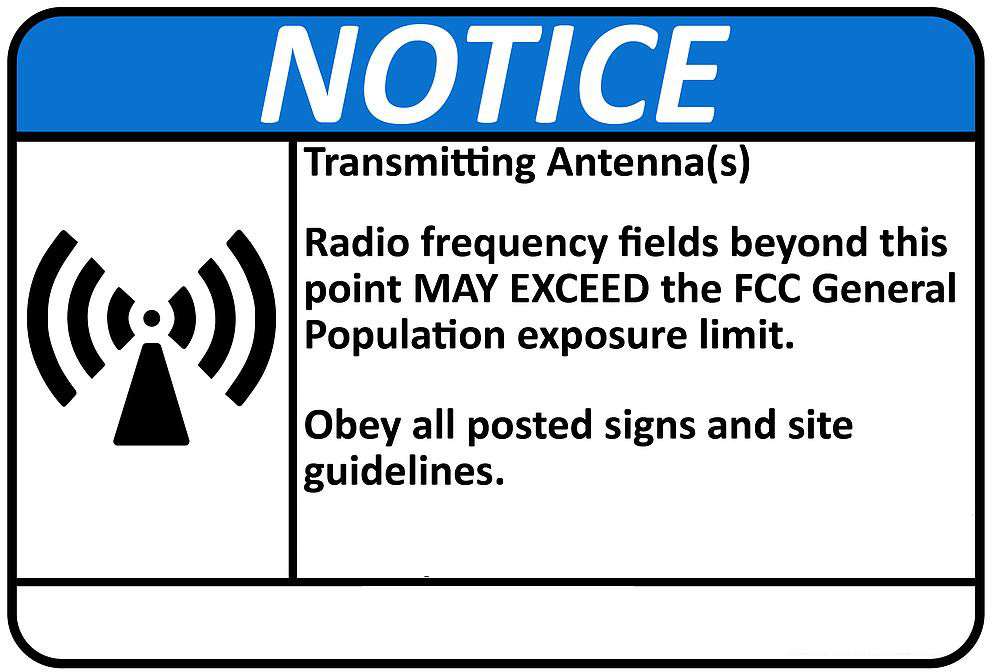
I’m getting ready to install a radio antenna on my home’s roof, and hoping to avoid hurting myself or anybody else in the process. While falling off the roof may be the most obvious risk, a less obvious concern is the radio frequency energy from the antenna when it’s transmitting. Is this something to worry about it? How much RF exposure is too much? Let’s take a look.
Electromagnetic waves in the radio frequency spectrum are what’s called non-ionizing radiation. They don’t have anywhere near enough energy to knock electrons loose from an atom or molecule. Unlike x-rays or gamma rays, they can’t cause radiation sickness, genetic damage, or cancer. The primary human risk from RF is heating up tissue – it can cause burns or literally cook you. This is how a microwave oven works, for example. There’s no risk for a human near an antenna that’s only receiving, but you need to be careful any time the antenna is transmitting. The risk depends on several factors, some obvious ones and some less obvious:
- Transmitter power – Higher power means higher RF energy levels.
- Distance from the antenna – The closer you are to the antenna, the higher your exposure.
- Transmitter duty cycle – Exposure is averaged over a period of several minutes. A 100 watt continuous transmission creates equivalent exposure to a 200 watt transmission alternating 1 minute on, 1 minute off.
- Height above ground – Radio waves can bounce off the ground and reflect back up, concentrating more of the total energy in a single spot.
- Proximity to buildings and nearby objects – Radio waves can also bounce off buildings, creating a similar effect to ground bounce.
- Antenna type – RF energy isn’t radiated equally in all directions. Some antenna types concentrate more energy at low elevation angles close to the horizon, or in specific directions. A human in the high-concentration zone will get higher RF exposure.
- Transmission frequency – The human body is most efficient at absorbing RF energy in the 30-300 MHz frequency range, so the risk is higher for radio transmissions in this range.
- Transmission mode: voice, digital, or Morse code – A 100W-rated radio that’s continuously transmitting may not be outputting 100W continuously; it depends on the transmitted signal. Continuous wave (CW or Morse Code) transmissions come closest to reaching the advertised power all the time. FM voice does too. But AM voice and single sideband (SSB, a type of AM) transmissions have an instantaneous output power that depends on how loudly you’re speaking at that moment. If you’re silent, the power is effectively zero.
In the United States, the FCC’s OET Bulletin 65 Supplement B describes the maximum permissible exposure or MPE limits for RF electromagnetic fields, and some methods used to calculate the exposure. MPE limits are defined in terms of power density (units of milliwatts per centimeter squared: mW/cm 2), electric field strength (units of volts per meter: V/m) and magnetic field strength (units of amperes per meter: A/m). Fortunately you don’t need to understand the details of all this, and can simply use their data tables to determine how far away people must be from the antenna in order to stay safe.
Controlled and Uncontrolled Exposure
The FCC sets two different MPE limits, for controlled and uncontrolled exposure. The controlled limits are higher, and they apply when people know they’re close to an antenna and have been trained to understand the potential risks. Typically this would mean a workplace setting, but controlled exposure limits also apply for licensed amateur radio operators and their families, assuming they’ve had RF safety training. The uncontrolled exposure limits apply to the general population, who may be completely unaware of the risks or who don’t know there’s an antenna present.
I don’t understand the reasoning behind this. Just because someone knows there’s an antenna, and has received RF safety training, how does that make their body less susceptible to injury from RF energy? If you can explain this, please do. For my home, I’m choosing to use the stricter uncontrolled general population exposure limits even though I’m not required to.
Doing the Math
Let’s look at some specific numbers. I’m installing a dual-band VHF/UHF antenna that’s a clone of the Diamond X30. It transmits at about 145 MHz for VHF, or about 450 MHz for UHF. It’s a vertical antenna with an omnidirectional radiation pattern in azimuth, but the pattern is squished vertically. More energy is radiated straight out toward the horizon, and less energy up or down where there’s usually nobody to talk to anyway. The radiation pattern is like a flattened donut, with the antenna centered at the hole in the middle.
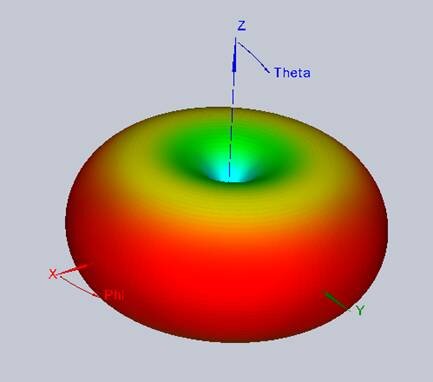
This particular antenna has a gain of 3.0 dBi for VHF and 5.5 dBi for UHF. This gain isn’t true amplification, it’s just a measure of how concentrated the RF energy is in the direction of interest relative to a hypothetical reference antenna. The “gain” comes from the degree of squishing in that radiation donut.
The radio uses standard FM modulation, and has a maximum output power of 25 watts, although most of the time I’ll probably run it at lower power.
Marshalling all this information, we could use the data tables in the FCC bulletin to estimate the minimum safe distance from the antenna for uncontrolled exposure. Fortunately several people have created easy-to-use calculators based on the FCC data, so let’s use this RF exposure calculator from Paul Evans VP9KF. Plugging in 25 watts, 3 dB gain, 3 meter distance, 145 MHz, with ground reflection, the calculator tells us 3 meters is safe and 2.27 meters (7.45 feet) would be the minimum distance. With 5.5 dB gain at 450 MHz, the safe distance is 2.47 meters (8.1 feet).
Going the Distance
8.1 feet isn’t a huge distance, but neither is it small. I probably don’t want to put that antenna directly outside the window from where I’ll operate the radio, or on the roof directly overhead that spot. Nor should it be anywhere that somebody might come and sit within 8 feet of it for an extended period of time. This might not be easy to achieve.
It’s important to understand that this 8.1 feet number is the most pessimistic and conservative number. It assumes my radio is continuously transmitting 100 percent of the time, which it certainly won’t be. It assumes the 25W from the radio is completely radiated as RF energy, when in fact some energy will be lost in the transmission cable to the antenna. It assumes the worst possible ground bounce. And it assumes a person is in the main lobe of the antenna’s radiation pattern, where the energy is concentrated. For this particular antenna, if it’s on the roof and people are below it, their RF exposure will be less because the antenna radiates most energy horizontally rather than up and down.
My planned location for the antenna is on a mast, mounted above the second story roof, above my garage. Yes my garage is on the second story of my home. Ideally the mast would be as tall as possible, but to minimize the visual impact and possible neighbor complaints, I’ll be using a very short mast – about 1 foot. If someone were standing at the back of my garage for an extended period of time, they’d be about 5 feet below the antenna. This might be a small concern, although it still meets the MPE for controlled exposure even before considering all the mitigating factors just mentioned. Outside the garage, it’s impossible to get closer than about 13 feet to the antenna unless you’re standing on the roof. We should be fine.
Read 11 comments and join the conversationInternational Space Station Downlink!
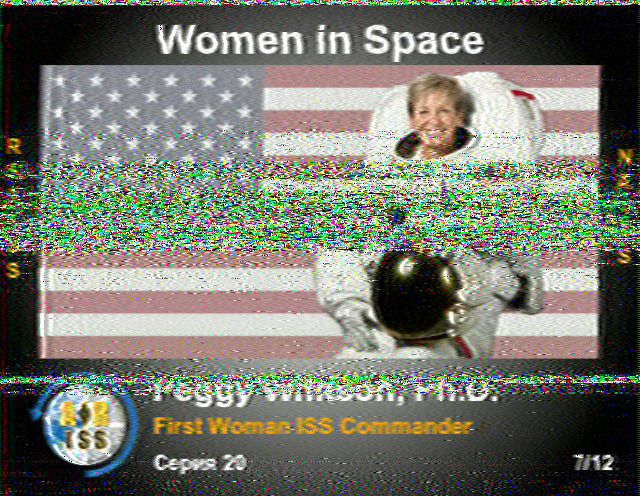
I downlinked a data transmission directly from the International Space Station! This amateur radio stuff is getting exciting. Using an orbital tracker tool, I found the time and location when the ISS would pass overhead here. From 9:16 AM to 9:21 AM, rising to the south, reaching its zenith to the southeast with 19 degrees elevation above the horizon, and setting to the east. I went to the top of a hill in my neighborhood, tuned my simple handheld radio to 145.800 MHz, pointed the antenna, and waited. And suddenly I heard crazy beeping! Dog walkers were staring.
Supposedly you should hold the antenna horizontally for best results, and perpendicular to the line to the ISS. But I just sort of waved the antenna around frantically, searching for the orientation that brought in the cleanest signal. I used the voice recorder app on my phone, holding the phone up to the radio speaker to record the beeping audio, while the wind made noise and cars drove by and the signal faded in and out. I captured almost all of one two-minute transmission and part of another, before the ISS went out of view. It was several minutes of recorded whistling and beeping.
Back home, I used some software called MMSSTV to decode the recorded audio, which was a PD120 slow-scan television image transmitted from the ISS, part of a special event celebrating women in space. The software provides options for tweaking the signal sync, phase, and image slant, because the Doppler shift screws up the signal when the ISS is moving by at 17500 miles per hour. Here’s the final decoded result. Peggy Whitson PhD, first woman ISS commander. Transmission received directly from Earth orbit, Sputnik style. Good morning!
Read 1 comment and join the conversationYellowstone Future Forecast
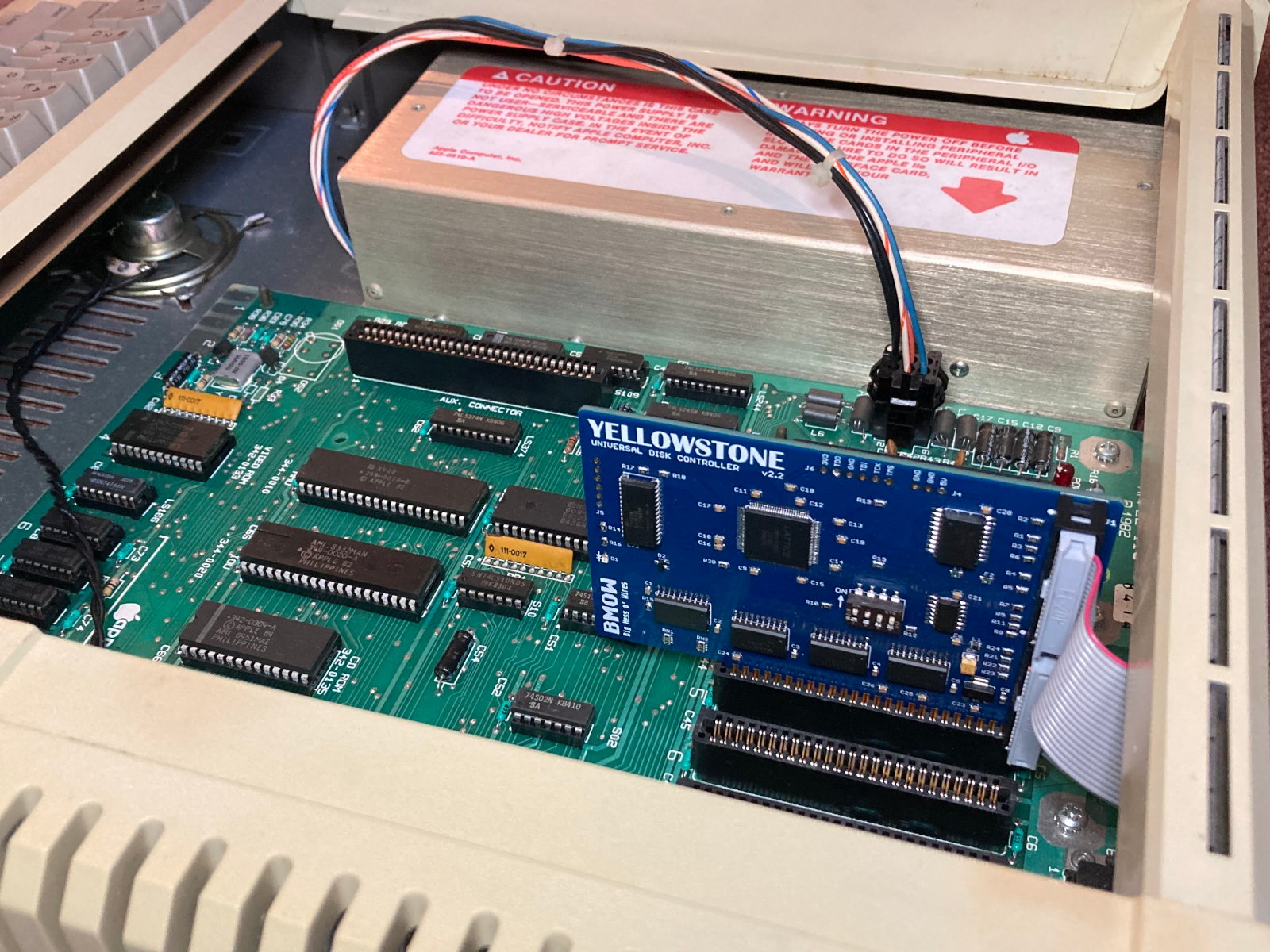
BMOW’s new Yellowstone Universal Disk Controller for Apple II computers has been popular in its first month of release. At the time of its announcement, I warned that parts supply constraints might make this the one and only manufacturing run of Yellowstone cards. That forecast now looks increasingly likely.
Ignoring the burst of Yellowstone sales immediately after its release, and extrapolating from the average daily sales rate more recently, there’s enough stock on hand to last until August or September. Unfortunately the Lattice FPGA at the heart of Yellowstone is out of stock everywhere, due to the global semiconductor shortage that keeps getting worse. The estimated factory lead time on new Lattice FPGAs is an eye-watering 67 weeks. Ouch!
I thought long and hard about placing an order anyway. After all, the sooner I place an order, the sooner I can eventually get the parts. But 67 weeks is a very long time, and that’s just an estimate. I’m not confident that Lattice really has any clue when they’ll be able to resume shipping these parts. It could be never.
Ultimately I decided I’m just not comfortable extending my plans until almost 2024. Will the other required Yellowstone parts still be available then, at prices to make the product viable? Will the product even still make sense to produce, or will it have been obsoleted by something else? Will I still be interested in this line of business in 2024? I’ve already invested money and time securing parts for planned future manufacturing runs of the Floppy Emu disk emulator and the ADB/USB Wombat input converter, expected roughly six months in the future. This already makes me nervous. 67 weeks “estimated” for the Lattice parts is just too much. That would demand making business plans on a cloud and a prayer.
This means when the current Yellowstone stock runs out this summer or fall, there won’t be any more inventory for a long time. I’ll keep an eye on the lead times for Lattice FPGAs and the other required parts. If the situation begins to improve, and it becomes possible to manufacture more Yellowstones with under 30 weeks lead time, I’ll consider jumping back in.
Read 7 comments and join the conversationUPS International Shipping Redlining in South San Francisco
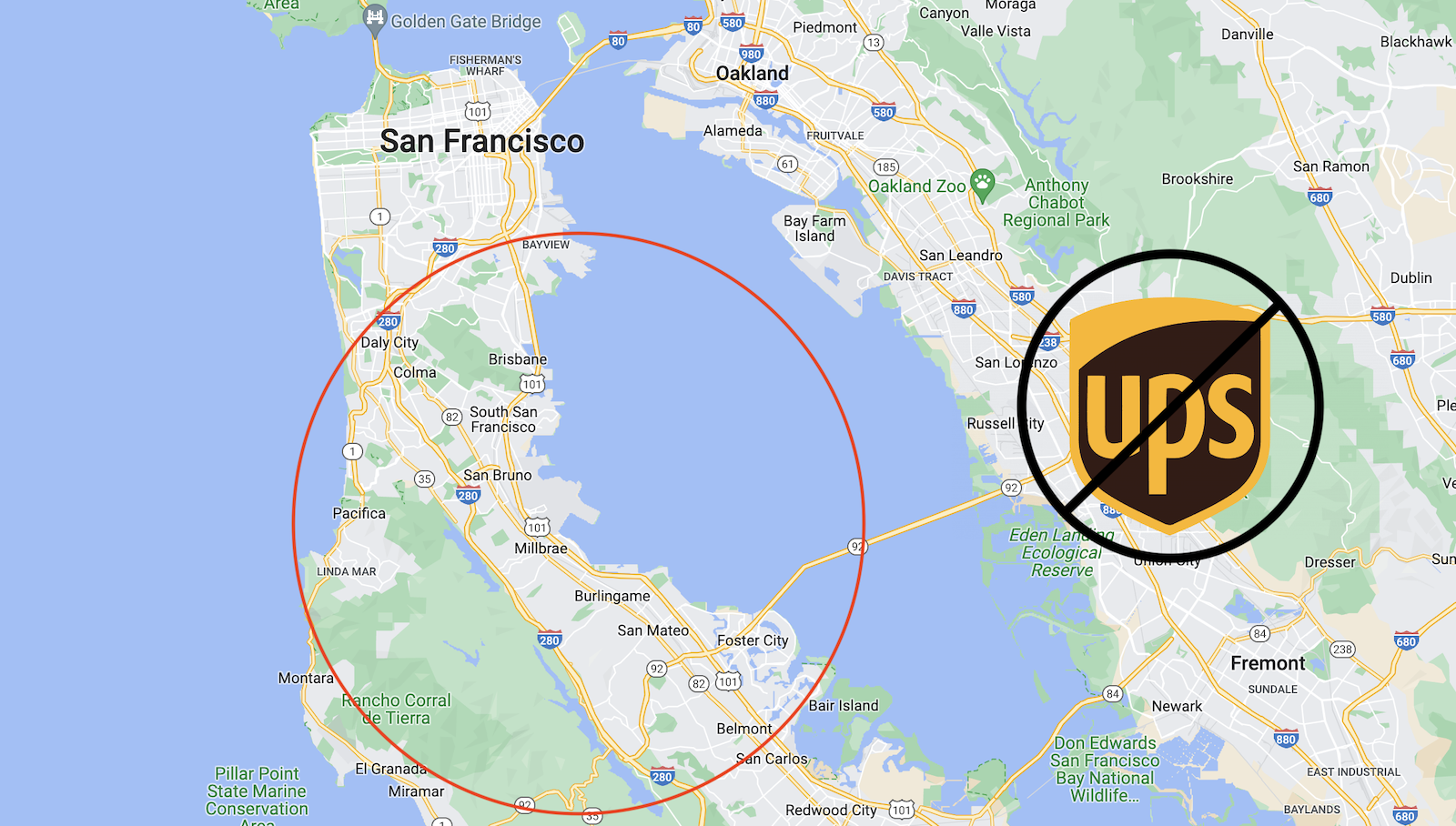
I’ve stumbled across a puzzling mystery. If you live in the southern part of the city of San Francisco, or in a large area further south into San Mateo County, UPS will not sell you international shipping labels. But change your Ship From zip code to a different city just a few miles away, and UPS will be happy to quote you for international shipping. I reached this conclusion after spending many hours pricing dummy international shipments with different Ship From and Ship To addresses, package sizes and weights, and content types. Only the Ship From address seems relevant. A UPS agent confirmed this behavior but couldn’t offer any explanation or solution.
I first discovered this problem on April 4, while using the third-party shipping service Pirate Ship to generate some UPS international shipping labels. For all my packages, Pirate Ship offered US Post Office shipping options, but nothing from UPS. After several hours working with Pirate Ship’s tech support, they concluded UPS was declining international shipping service to this region for some unknown reason. They told me to take up the issue with UPS.
Initially I didn’t believe Pirate Ship’s explanation, but then I discovered I could reproduce the same problem directly at the UPS.com page for international shipping quotes. You can try this too. Go to the UPS international shipment cost calculator page, as a guest (not logged in). Enter these package details:
Ship From: United States, Redwood City, zip code 94065. Or mostly anywhere else in the United States, except one of the redlined areas listed below.
Ship To: France, postal code 75008, Paris. Or try any another major city in Europe, Asia, wherever, it doesn’t matter.
Customs Value: 119
Package Details: My packaging, 11 x 9 x 2 inches, 0.8 pounds, 119 dollar value
You’ll see a list of available UPS shipping methods with specific price quotes. For example, UPS Worldwide Expedited service costs $154.44 to Paris. You’ll get the same behavior with Ship From addresses in most parts of California or elsewhere in the United States.
Now try the same experiment again, but for the Ship From location, choose one of the following cities and zip codes. These cities are a contiguous geographic region just south of San Francisco, centered around the San Francisco airport. The total population is about 1 million people.
94002 Belmont
94403 San Mateo
94402 San Mateo
94401 San Mateo
94404 Foster City
94010 Burlingame
94030 Millbrae
94128 San Francisco
94112 San Francisco
94132 San Francisco
94066 San Bruno
94080 South San Francisco
94019 Half Moon Bay
94044 Pacifica
94015 Daly City
94005 Brisbane
When you repeat the test using one of these Ship From addresses, UPS.com complains:
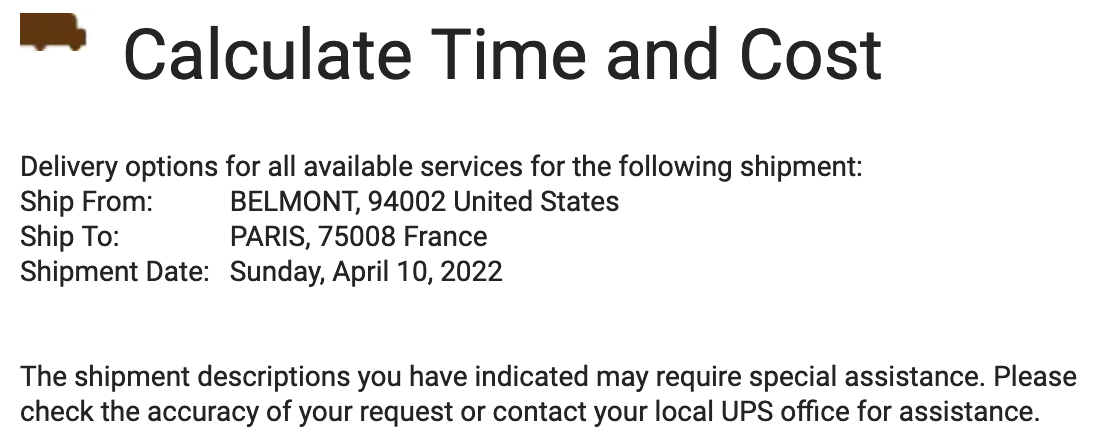
The shipment descriptions you have indicated may require special assistance. Please check the accuracy of your request or contact your local UPS office for assistance.
This is consistent with the apparent UPS international shipping redlining that I observed when using Pirate Ship. I spoke with the staff at the local UPS Store, but they’d never heard of this problem, and said their outgoing international shipments were working just fine. Through trial and error, I discovered that Shopify Shipping isn’t affected by this problem either, so it may have something to do with the class of UPS shipping account used to buy shipping labels. The problem definitely affects Pirate Ship, UPS.com’s own shipping quote system, and probably others too.
I then spent a long time on the phone with other UPS support agents who told me I was wrong, and that the Ship From zip code didn’t matter for determining international shipping service availability. On the third try, I was finally able to demonstrate the problem to a UPS agent, but she could only say “I don’t know why it’s doing that”. She couldn’t offer any explanation or solution. That was several days ago, and the problem is still happening today.
Read 5 comments and join the conversationMy First Amateur Ham Radio Contact Attempt
My new interest in amateur radio is taking off. After a couple of weeks studying, I took the ham Tech and General license exams on Saturday, and passed them both. Today the FCC updated their license database and created a new call sign for me, which means I can now legally transmit on the amateur radio bands. With my freshly-awarded operator’s license and a new radio, I tried getting on the air for the first time. It didn’t go exactly according to plan.
Read 1 comment and join the conversationNow Available: Yellowstone Universal Disk Controller for Apple II

It’s finally here! After more than four years in development, I’m pleased to announce that BMOW’s Yellowstone Universal Disk Drive Controller for Apple II is available and shipping now. Yellowstone combines the power of an Apple 3.5 Disk Controller Card, a standard 5.25 inch (Disk II) controller card, the Apple Liron disk controller, and more, all in a single card. It supports virtually every type of Apple disk drive ever made, including standard 3.5 inch drives, 5.25 inch drives, smart drives like the Unidisk 3.5 and the BMOW Floppy Emu’s smartport hard disk, and even Macintosh 3.5 inch drives. Yes, pull the internal 3.5 inch drive from an old Mac and use it directly with your Apple II!
Yellowstone Features
- Add 3.5 inch drive and smartport hard disk support to your Apple IIe or II/II+
- Provide more disk connectivity options for your Apple IIgs
- Bring Macintosh 3.5 and naked Apple 3.5 inch drive mechanisms to the Apple II
- Drop-in replacement for an Apple Liron controller card (with optional DB-19F adapter)
- Drop-in replacement for a standard 5.25 inch or Disk II controller card
- Run two drives of different types on twin independent disk connectors
- Disk II controller emulation mode for tricky copy-protected disks
- Works with DOS 3.3, ProDOS, GS/OS, and more
- User-upgradable firmware for future feature enhancements
- 20-pin ribbon cable connectors or optional 19-pin D-SUB connectors
Yellowstone includes two independent disk drive connectors on the card, and supports drives with rectangular ribbon connectors as well as drives with D-shaped 19-pin DB-19 connectors. The standard Yellowstone card includes two rectangular connectors built-in on-board, and DB-19 female adapters are available separately if needed for use with 19-pin drives. There’s also a Yellowstone Everything Bundle that packs the Yellowstone card with two DB-19 female adapters into a single combined package.
The Yellowstone hardware is powered by an FPGA – a programmable logic device that replicates the behavior of the IWM chip and various support chips normally found on other disk controller cards. This gives Yellowstone unparalleled flexibility and control over every aspect of disk I/O, and the ability to change its behavior through firmware updates.
Limited Availability
If you’re interested in getting a Yellowstone card, don’t wait too long. At the risk of sounding like a late-night infomercial, “supplies won’t last”. The global chip shortage has created major problems for parts availability, and the FPGA chip at the heart of Yellowstone is no longer available anywhere, with estimated factory lead times of more than a year for new parts. If anyone has a lead on some Lattice LCMXO2-1200HC-4TG100 chips that could be delivered before 2023, let me know! The DB-19 female connectors have also become unobtanium. These aren’t manufactured anymore, and the only available sources are dusty new-old-stock from the 1990s. Once the supply of DB-19 females is gone, they’re gone and that’s the end. BMOW has enough Yellowstone hardware in stock to meet a few months’ worth of estimated sales, but beyond that the outlook is uncertain, and it may be 2023 or later before a resupply is possible. Lucky for you, there are plenty of them in stock right now.
Universal Drive Support
Need to attach a disk drive to your Apple II? Yellowstone has got you covered. Yellowstone is compatible with all the disk drives shown in this stack, plus many more. See the instruction manual for complete details.
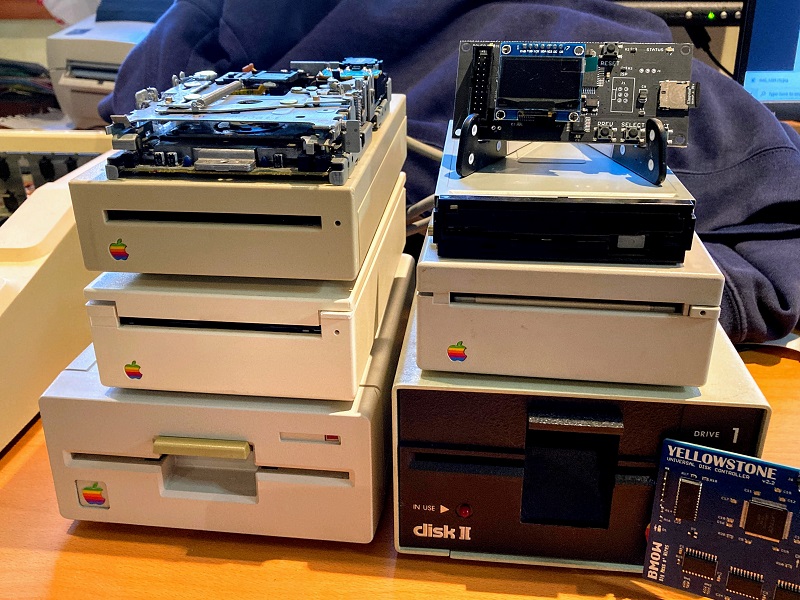
Final Testing, One Last Moment of Panic
These Yellowstone boards were all tested by the contract manufacturer, using the automated Yellowstone test rig that I’ve described previously. But of course for this first batch, I’m going to spot test some boards at home before I put them in the store. So I grabbed a few from the shipping box, popped one into my Apple IIe, and… it didn’t work. After 10 minutes of troubleshooting I couldn’t figure out what was wrong, and I nearly had a heart attack imagining that the whole lot of Yellowstone boards had some systemic design error. Then I noticed the ribbon cable that I’d grabbed off my desk for testing:
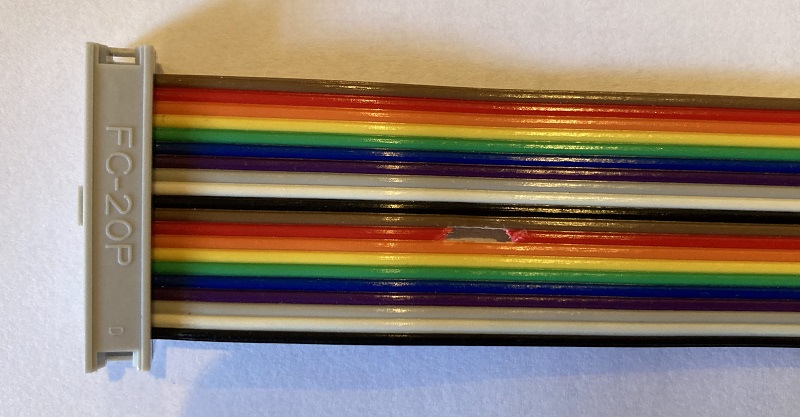
Notice anything strange about this cable, like a giant hole in one of the conductors? Why, Steve, why?! I don’t remember why I originally made this hacked cable, but I curse myself now for leaving it on my desk where I’d accidentally pick it up six months later.

Available Now
If you own an Apple IIe, Apple IIgs, Apple II+, Apple II, or Apple II clone with expansion slots, Yellowstone is the disk controller card you’ve been waiting for! Check out the complete details in the Yellowstone instruction manual, or buy one now at the BMOW Store.
Read 23 comments and join the conversation
